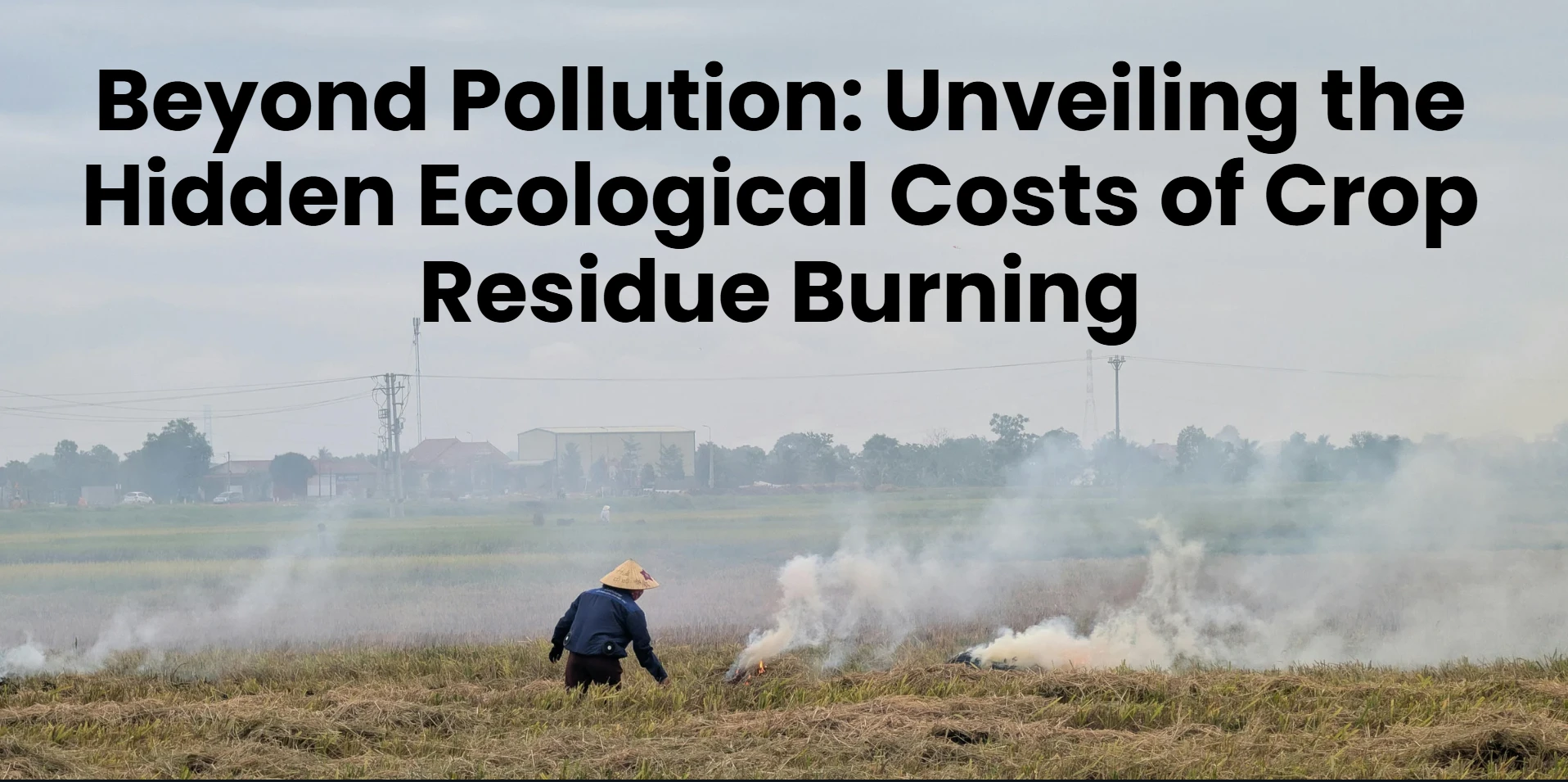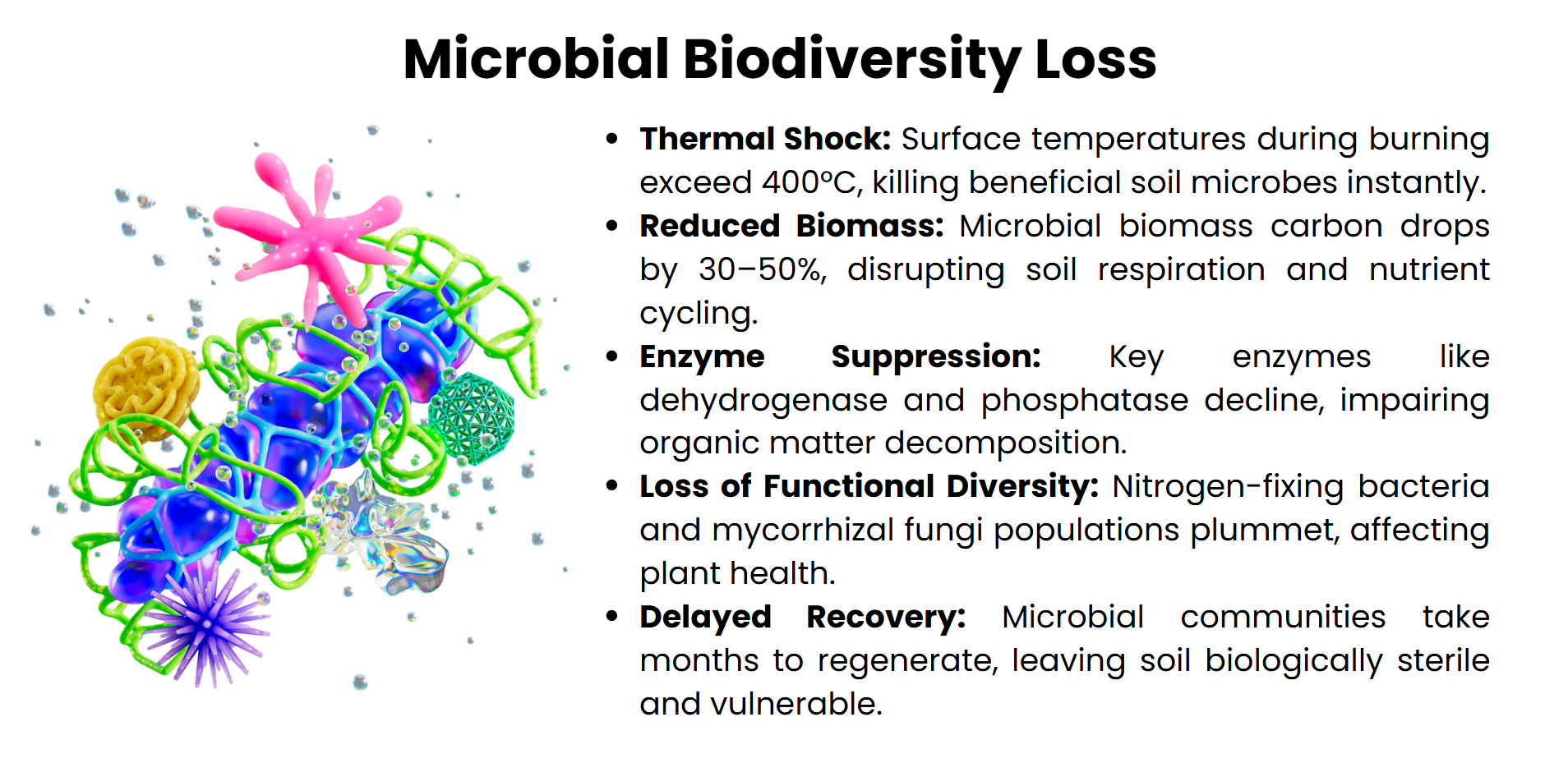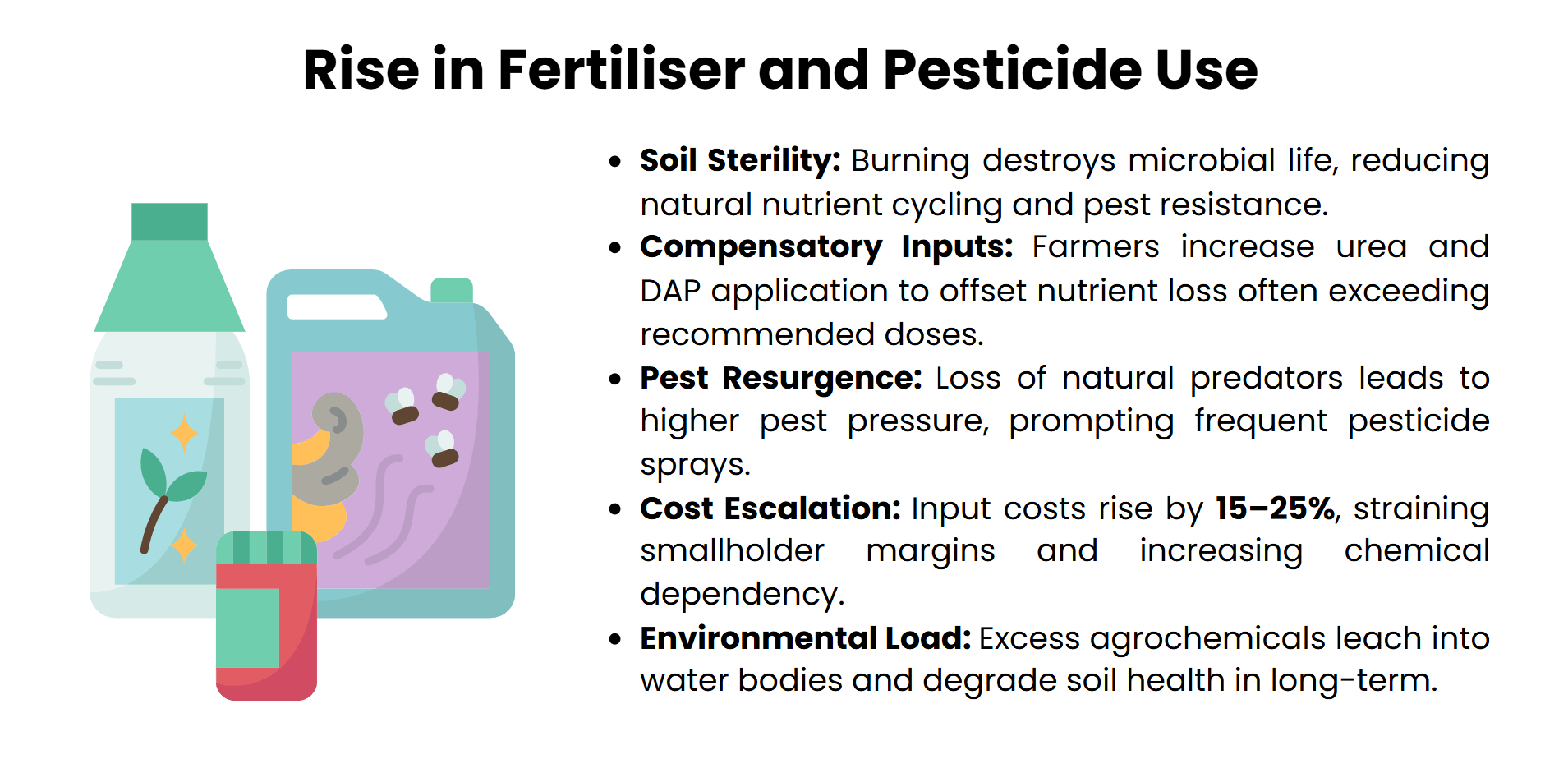"Beyond Air Pollution" refers to elements of the air pollution crisis that proceed beyond its immediate presence, such as its transboundary nature across borders, its effects on mental and cognitive health, the financial costs associated with increased illness and lost productivity, and the requirement for large-scale airshed management compared to just local action to effectively mitigate the problem.Soil microbes rely on crop residue practices and the fact that crop residue burning will only cause more problems, including damage to the soil, pests and predators, which is needed to control the pests and enhance the soil.

In northern India, particularly Punjab, Haryana and western Uttar Pradesh, burning crop residue is also a common agricultural practice as the harvest in this region is mechanized, leading to voluminous residues left in the fields. Although the impacts of this practice on seasonal air pollution and public health emergencies have been discussed to a large extent, recent evidence suggests that the ecological impacts of the practice are far beyond atmospheric degradation. However, there is a distinct lack of studies looking at the effects of stubble burning on soil microbial diversity, pest loading and numbers of natural predators, all of which are important to agricultural sustainability in the long run.Air pollution is the presence of substances in the air that are harmful to humans, other living beings or the environment.Research to date has found that the heavy heat produced during the process of combusting residues changes soil temperature dynamics, disturbs the microorganisms needed to recycle nutrients, and enhances the losses of important nutrients through volatilization. Meanwhile, the dismantling of the surface-dwellingorganisms like spiders, ladybirds, and amphibiousorganisms eliminates the natural pest control mechanism, which increases the repetition of pests and stimulates the use of pesticides and fertilisers. These secondary disturbances not only render soil unhealthy and reduce farm yields but also increase dependency on chemical fertilizersfor farmers, putting even more stress on the environmental as well as the financial prosperity of these farmers.By drawing on ecological, agronomic and policy angles, this article proposes a paradigm shift in the way crop residue management is viewed, i.e., one that would elevate the value of biodiversity conservation and soil stewardship while developing farmer-friendly and scalable alternatives to open burning.
The Practice and its Persistence
Although crop residue burning is an environmentally degrading practice, it has continued to persist in agricultural sectors in Northern India. Its perseverance is characteristic of a compound interaction between economic, technological and institutional considerations.
Economic Needs and Lack of Time
Burning the stubble is a cheaperand faster way of clearing land between growing periods for many farmers and especially for smallholders whose farmlands do not involve the use of machinery. This small period of time between the harvest of paddy and planting of wheat, usually under 15 days,causes no time to tackle the labor-intensive matters of residue management. Machinery-based substitutes like the Happy Seeder and the Super Straw Management System is promoted through subsidies but is still not financially feasible or logistically viable or affordable to many people. The average paddy straw burnt in the state of Punjab per annum is well above 23 million tonnes mainly because of time and cost constraints (ICAR, 2023)
Technological Lag and Low Acceptance
Although in-situ decomposition technologies as well as residue incorporating machinery are available, adoption is not homogenous. Not all the farmers are conscious or well positioned to apply these remedies in practice. In addition, the bio-decomposers have different performances depending on soils and climatic areas making them unreliable. The lack of decentralized facilities of straw collection and use such as biomass-based energy plants or fodder storage also inhibits feasible substitutes to burning.
Policies and Difficulties Enforcement
State governments have introduced bans and fines on stubble burning, but that is not consistently enforced and is resisted in several cases. Farmers complain that punitive actions are blinded towards structural constraints and do not provide scalable and farmer based solutions. The National Green Tribunal and Supreme Court repeatedly called to coordinate the activities, but the activity still remains divided among the departments and jurisdiction (MoEFCC, 2024).
Cultural Normalization and Behavioural Inertia
With decades, burning of residues has become an acceptable farming practice. What is needed more than technology solutions to alter this behaviour is enduring relationships, trust-based and participatory extension models to align ecological aims with the realities of the farmers.
Microbial Biodiversity: The Unseen casualty
Crop residue burning does not only change atmospheric conditions, but also has an irreparable impact on the soil ecosystems. This effect is one of the least noted disruptions in microbial biodiversity, a foundational structure of field and crop health.

Microorganisms and Their Ecological Role
Some of their key tasks conducted by soil microbes include breaking down organic matter, mineralising nutrients, and nitrogen fixing. These organisms control the structure of soil, increase plant immunity, and help in fertility in the long term. Their productivity and how diverse they are depend closely on soil resilience and productivity. Microbial richness is the primary indicator of the sustainability of an agro-ecosystem, especially areas of intensive agriculture.
Habitat Destabilization and Thermal Stress
Burning of crop residues produces surface temperatures above 300C that sterilizes the top layers of soil and kills microbial habitats. Thisleads to a significant reduction in microbial biomass and enzyme activity caused by this thermal shock. Indian Agricultural Research Institute (IARI) studies found that due to the post-burning, the rates of microbial respiration are reduced by 40-60%, which is a serious mark of biological stress (IARI, 2022).
The Long-term Implications to Soil Functionality
Microbial loss of diversity undermines nutrient cycling, especially phosphorus solubilisation and nitrogen fixation processes, and farmers have to depend more on synthetic fertilisers. Not only does this heighten the costs of input, but it also hastens soil degradation. Also, the loss of microbial network compromises the soil resilience towards environmental perturbations, in the same way it can be affected by drought or insect epidemics. Such depletion of biological capital wears down the regenerative power of agricultural farmers over the long term.
The need to manage soil on a microbial level
Changing the residue management practice is mandatory to consider microbes an essential associate in sustainable farming. In-situ processes can be improved by encouraging in-situ decomposition, inoculation with microbes, and Organic amendments can also restore biological equilibrium. Policy systems have to incorporate it into the recitation of microbial health within soil conservation measures.
Rising Pests and fidelity to fertiliser
On top of the destruction of soil ecology, the crop residue burned by the farmers leads to biological maladjustment and a cascading effect in terms of the soil fauna.
Loss of Ecological Checks and Balances
Burning stubble eliminates the organisms that live on the surface and acts as a natural pest control mechanism. Ladybirds and ground beetles, spiders and amphibians like frogs are creatures extremely sensitive to the destruction of habitat and heat. Their impoverishment results in of out-of-control population of aphid, whitefly and the stem borer depleting it of the necessary biological checks and balances. Residue burning reduced the density of predators by 70% in two weeks and was accompanied by a surge in crop damage caused by pests in the Indo-Gangetic Plain (study).
Enhanced use of chemicals and imbalance inthe soil
Farmers use more chemical fertilisers and pesticides to sustain yields at a time when there is a loss of natural pests’ protection mechanisms. This reactionary method increases the cost of production and it also disrupts soil nutrient dynamics. FAI (2024) reported a 15-20% higher urea usage per hectare in stubble burning areas, suggesting an additional coverage of upturned soil once the fertile status of the soil starts to decline.
Terrible Cycle of Ecological Degradation
The inputs used chemically suppress the desirable soil organisms leading to the decline in natural resistance to pests and diseases. This long-term destabilization of agroecosystems makes them more susceptible to stress factors caused by climate. The system can be shifted to a chemically-dependent path with the loss of environmental sustainability and economic sustainability unless some action is undertaken to reverse the trend.

Toward Integrated Pest and Nutrient Management
In order to overcome this obstacle, integrated pest management (IPM) and soil-focused nutrient practices must be prioritized. Biological control agent, crop diversification, and residue recycling can be promoted to restore ecological balance and to eliminate chemicals dependence.
Draining of the Soil Health
Burning of crop residue has a harmful and deteriorating effect on the soil health that is caused due to the speedy thermal and conflagration change in the up most level of the soil. The high temperatures that result in the combustion process- usually above 300C- destroy the organic matter, volatilize the required nutrients like nitrogen, phosphorus, and sulphur as well as interfere with the physical stability of the soil. The changes decrease both the ability of the soil to hold water and to sustain microbial activity, causing a long term conversion to sterility.
The reduction in organic carbon concentration is worrying especially in its compromising effect to soil aggregation, soil aeration, and buffering capacity of nutrients. CSSRI (2023) notes that soil organic carbon has decreased by up to 25 per cent after a ten-year period of repeated stubble burning in Indo-Gangetic regions. This impoverishment affects the root growth and makes it vulnerable to erosions and compaction.
Also, microbial diversity, which is essential in nutrient cycling and plant-microbe interactions, is lost thereby compromising soil functionality as well. Enzymatic processes e.g., dehydrogenase and phosphatase that are indicators of the biological health of the material also become significantly impaired after burning. Such interferences require more use of synthetic fertilisers and thus, a pattern of dependency and environmental degradation is driven.
Efforts to restore soil health will involve a change to residue management, organic soil amendments, and microbe applicationswhich will restore a biological balance and improve long-term yields.
A different policy and sustainable alternatives
India has seen changes in the policy response to crop residue burning in the past ten years, but roadblocks exist in transforming support to large-scale change.
- The initiatives of the government like Promotion of Agricultural Mechanization of In-Situ management of crop residue (2018) have given subsidies to equipment like the Happy Seeder and the Super SMS to reduce burning.
- Nonetheless, adoption is lopsided; this is because of operational expenses in its use, poor accessibility to machinery and poor extension services (MoA&FW, 2023).
- Some recent technological breakthroughs such as the Pusa bio-decomposer, designed by Indian Agricultural Research Institute present excellent biological solution available in-situ residue degradation.
- Field experiments in Delhi and western Uttar Pradesh also demonstrated the positive effects of ACC as it enhanced soil texture and decreased the number of burning cases, but its effectiveness depends on climatic and soil characteristics (IARI, 2022).
- Moreover, decentralized system, which includes community straw bank, biomass energy plants and farmer cooperatives to handle residue harvesting, are workable but need institutional support and market integration.
- A further response to this would be the shift to adopting agro-ecological methods including crop diversification, conservation agriculture and integrated nutrient management that would minimize the need to burn residues. To boost their implementation and permanence, the stratagems should be embedded in state-level climate action plans and encouraged with carbon credit or sustainability-linked subsidy regimes.
Conclusion
Crop residue burning has long been considered mainly at the air pollution level, but a wider ecological and agronomic accounting is now required. Its effects on microbial diversity and faunal ecology, development of pests and soil health depict a subdued offence to pillars of one of the sustainability boons of agriculture. The weakening of the natural predators, more dependency on the chemicals, and erosion of biological resiliency all indicates a stressed system, which would not be solved only with the help of punitive measures. Solving this dilemma will see radical paradigm change by moving towards proactive approach through farmer-oriented solutions that incorporate science, policy, and community involvement. Institutional support and behavioural change should be coupled with scaling sustainable alternatives like bio-decomposers, mechanization in the residue management and agro-ecological practices. Ultimately, protection of soil and biodiversity is not merely an environmental need, but also an essential requirement to protect the food security, rural livelihoods and climate resilience in India. This journey of achievement must start by considering that healthy soils and living ecosystems are the real foundation of agricultural development.